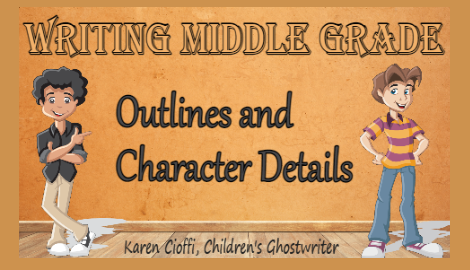
The majority of my clients ask for picture books, but currently, I’m working on two middle grades.
While a middle grade book can be significantly shorter than a novel, it still has a big chunk of words at around 20-50,000. Quite a difference from the under 800-word picture book.
When I write a picture book story, I use the seat-of-the-pants method of writing. With around 600-800 words, I find it works well.
This is not the case with a middle-grade story. Writing a middle-grade is similar to writing a novel, so the same practices should be used. Because of this, I use an outline.
CREATING AN OUTLINE
With an outline, you can make it as detailed as you like.
Being impatient, I used to write as bare an outline as possible. I’ve found, though, that writing a more detailed outline is a huge help when getting down to writing the story.
This became particularly apparent to me when a client from five years ago recently called me.
I had written one middle grade for him and started a second one. For some reason or other, the client stopped the project after a month into it.
He now wants to resume the project … after five years.
Fortunately, I keep good records and files. I make sure I have them backed up. In fact, I use Dropbox and Carbonite. I also have an external drive that I back my files up to.
Overcautious?
Maybe, but I’ve had the experience of losing a client’s project – the entire manuscript – due to a computer mishap, so I take extra precautions.
Because I save everything, I have the information from the first book and what I had done on the second book.
Going over my notes, I was THRILLED to see that I had written a detailed outline of Book 2.
Granted, this is an unusual situation as this is the first time I’ve had a client stop a project, and especially stop one for such a very, very long time, but it helps emphasize the importance of an outline.
Having that detailed outline is going to save me time and effort.
CREATING CHARACTERS
Along with creating an outline, it’s important to develop character details.
Writing coach and children’s author Suzanne Lieurance says that if you know your characters before writing your story, you’ll write a better novel.
Why?
Well, if you take the time to create your characters, especially the main characters, you can open up other details or subplots within the story that you might not have thought of before.
This also helps you to create unique characters. Characters with their own personalities and quirks that make them easily distinguishable from the other characters.
You’ll know that Jeff has a temper, Russell is timid, and they’re best friends despite their differences.
You’ll know that Marisa has a crush of Matteo, who has a crush on Abby, who likes Jeff.
All this is going on behind the scenes in subplots as the main character struggles to reach his goal.
Being aware all this will allow you to know how a character will react in certain situations. It’ll also help you write particular scenes with ease.
I hope these tips help you write an outstanding middle-grade story.

I’m a working children’s ghostwriter, rewriter, and coach. I can help turn your story into a book you’ll be proud to be the author of, one that’s publishable and marketable.
OTHER HELP I OFFER:
HOW TO WRITE A CHILDREN’S FICTION BOOK
A DIY book to help you write your own children’s book.
FICTION WRITING FOR CHILDREN eCOURSE
4-Weeks / 8 Sections Guided Self-Study Mentoring Program
You can contact me at kcioffiventrice@gmail.com.
MORE ON WRITING
The 3 Levels of Children’s Picture Books
The One Sentence Pitch for Your Manuscript
How Do You Build a Successful Writing Career? (3 Tips)

1 thought on “Outlines and Character Details – Tips on Writing a Middle Grade Story”